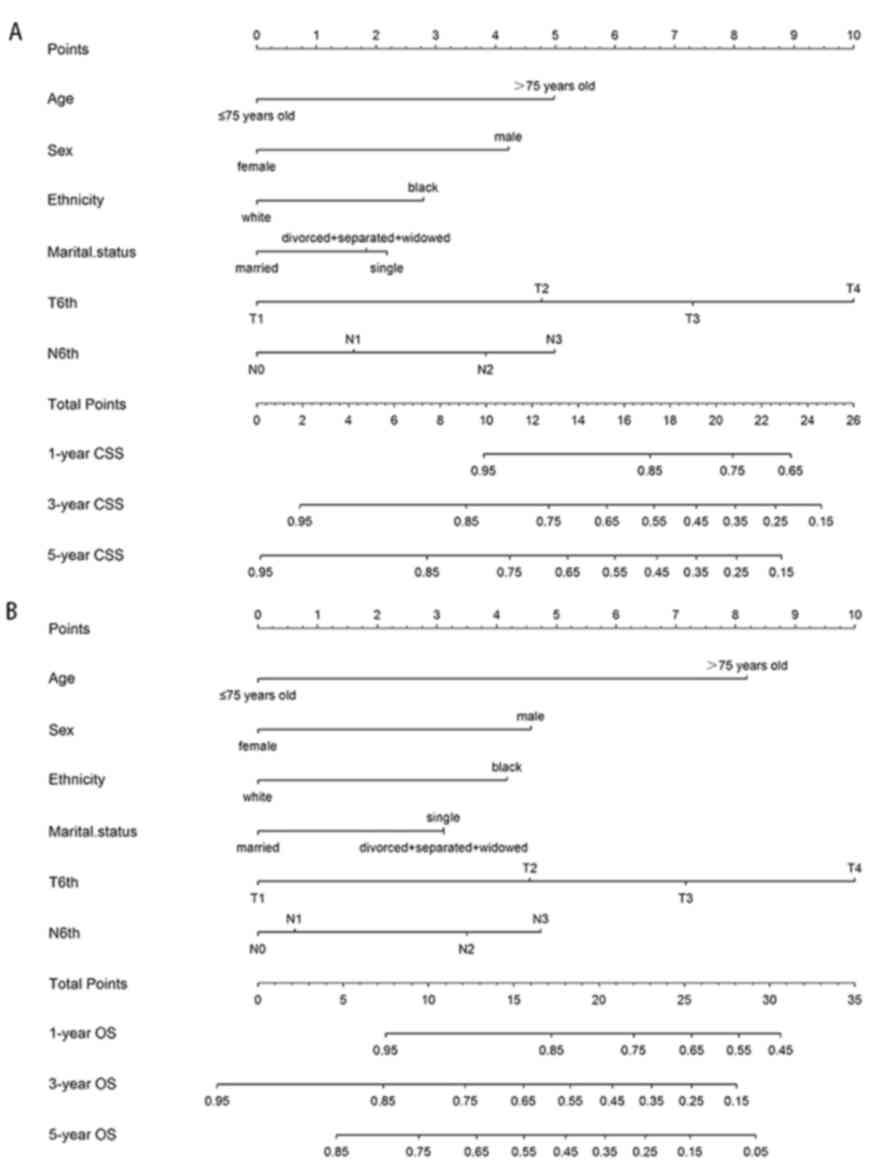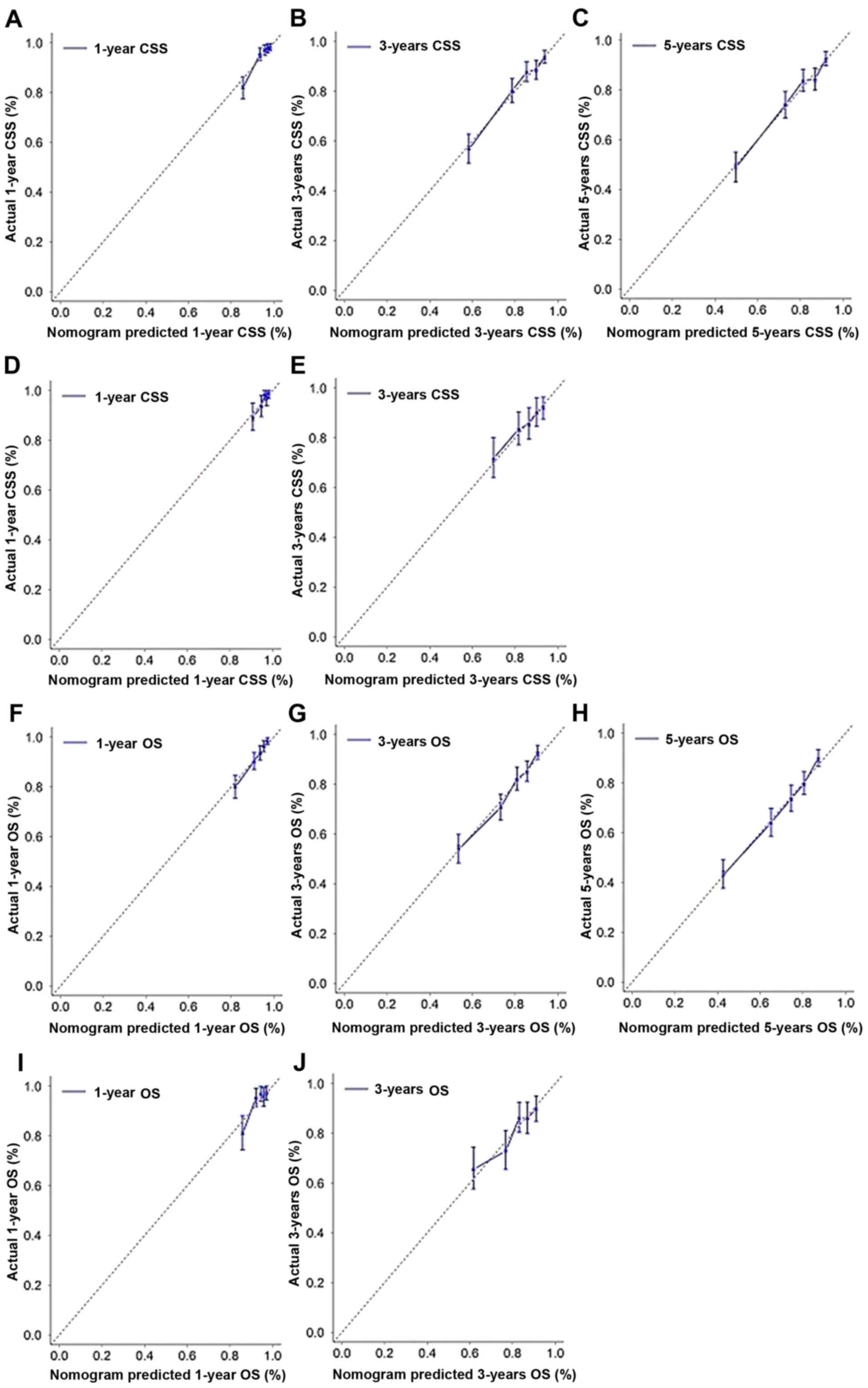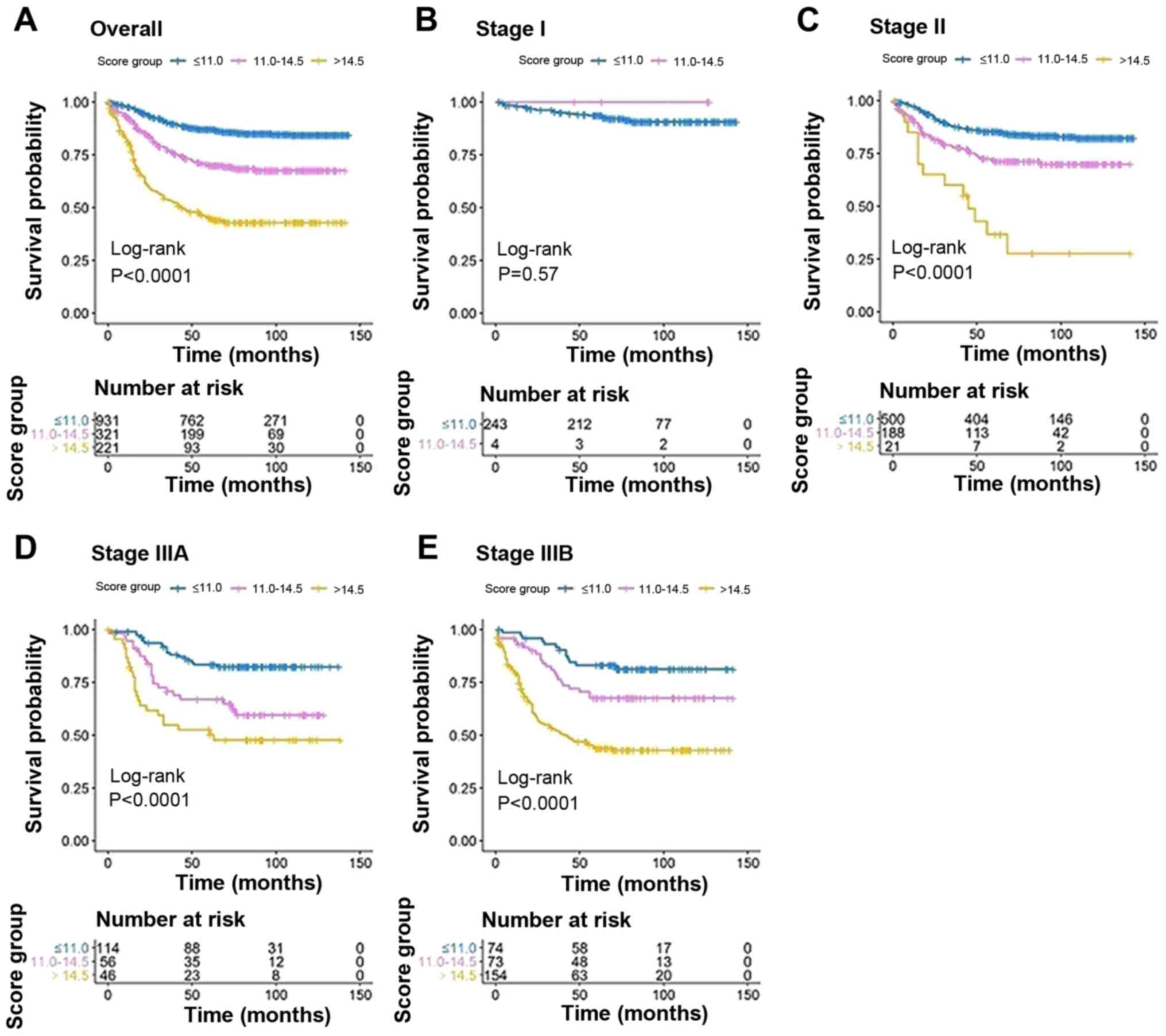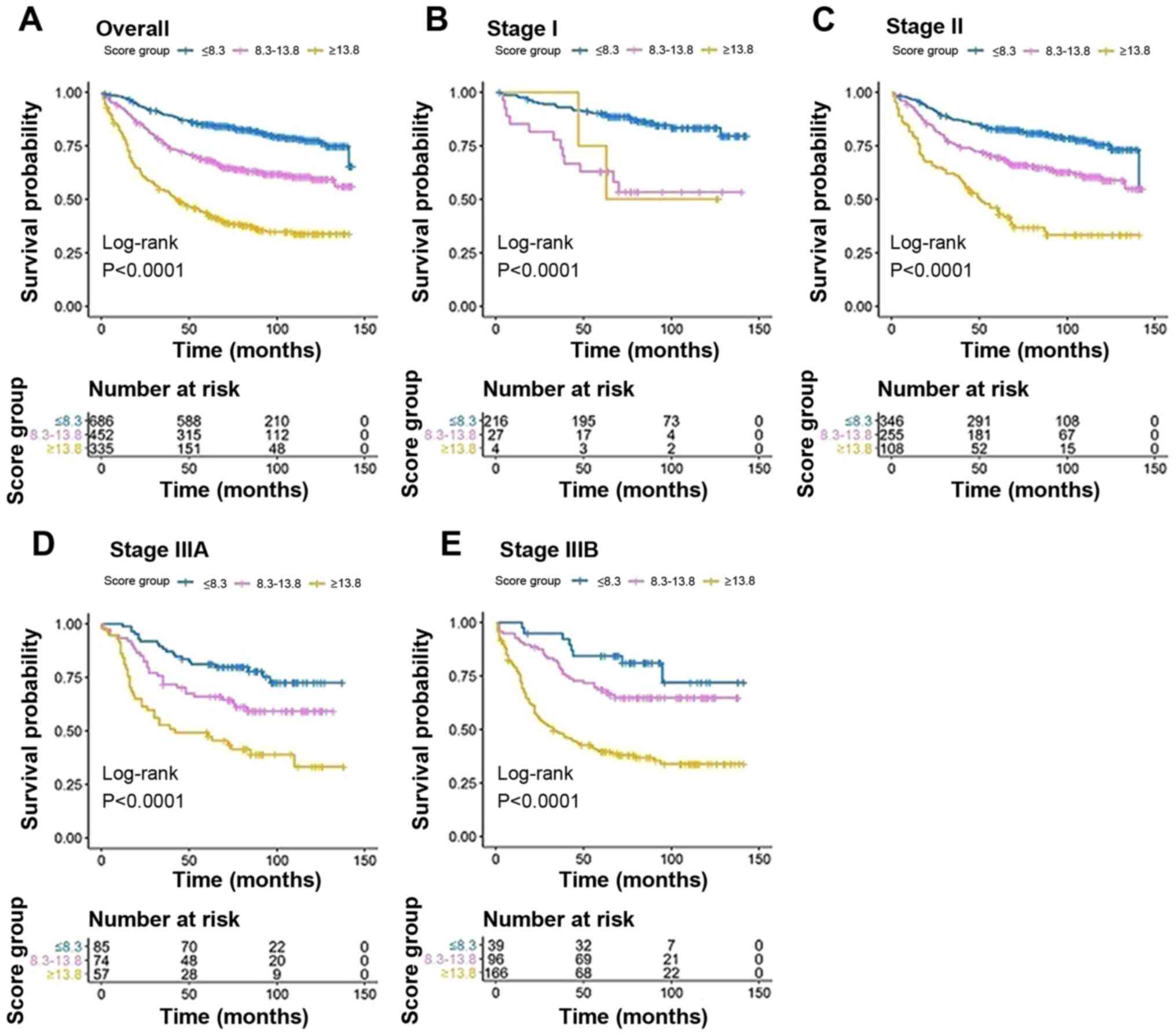|
1
|
Jemal A, Siegel R, Ward E, Hao Y, Xu J and
Thun MJ: Cancer statistics, 2009. CA Cancer J Clin. 59:225–249.
2009. View Article : Google Scholar : PubMed/NCBI
|
|
2
|
Karanjawala BE and Chang GJ: Management of
Anal Cancer. 2015. View Article : Google Scholar
|
|
3
|
Nieder C: Concurrent radiochemotherapy
with 5-FU/mitomycin remains standard treatment for anal carcinoma.
Long-term results of the phase III RTOG 98-11 trial. Strahlenther
Onkol. 189:512–513. 2013. View Article : Google Scholar : PubMed/NCBI
|
|
4
|
Nigro ND: An evaluation of combined
therapy for squamous cell cancer of the anal canal. Dis Colon
Rectum. 27:763–766. 1984. View Article : Google Scholar : PubMed/NCBI
|
|
5
|
Franco P, Mistrangelo M, Arcadipane F,
Munoz F, Sciacero P, Spadi R, Migliaccio F, Angelini V, Bombaci S,
Rondi N, et al: Intensity-modulated radiation therapy with
simultaneous integrated boost combined with concurrent chemotherapy
for the treatment of anal cancer patients: 4-year results of a
consecutive case series. Cancer Invest. 33:259–266. 2015.
View Article : Google Scholar : PubMed/NCBI
|
|
6
|
Epidermoid anal cancer: Results from the
UKCCCR randomised trial of radiotherapy alone versus radiotherapy,
5-fluorouracil, and mitomycin. UKCCCR Anal Cancer Trial Working
Party. UK Co-ordinating Committee on Cancer Research. Lancet.
348:1049–1054. 1996. View Article : Google Scholar : PubMed/NCBI
|
|
7
|
Giroux D, Meerbeeck JV, Crowley JJ,
Sculier JP and Chansky K; Goldstraw PJCJoLC, : The international
association for the study of lung cancer staging project.
13:792–801. 2010.
|
|
8
|
Kawaguchi T, Takada M, Kubo A, Matsumura
A, Fukai S, Tamura A, Saito R, Maruyama Y, Kawahara M and Ignatius
Ou SH: Performance status and smoking status are independent
favorable prognostic factors for survival in non-small cell lung
cancer: A comprehensive analysis of 26,957 patients with NSCLC. J
Thorac Oncol. 5:620–630. 2010. View Article : Google Scholar : PubMed/NCBI
|
|
9
|
Sculier JP, Chansky K, Crowley JJ, Van
Meerbeeck J and Goldstraw P; International Staging Committee and
Participating Institutions, : The impact of additional prognostic
factors on survival and their relationship with the anatomical
extent of disease expressed by the 6th Edition of the TNM
Classification of Malignant Tumors and the proposals for the 7th
Edition. J Thorac Oncol. 3:457–466. 2008. View Article : Google Scholar : PubMed/NCBI
|
|
10
|
Kim MK, Jo H, Kong HJ, Kim HC, Kim JW, Kim
YM, Song YS, Kang SB, Mok JE and Lee HP: Postoperative nomogram
predicting risk of recurrence after radical hysterectomy for
early-stage cervical cancer. Int J Gynecol Cancer. 20:1581–1586.
2010.PubMed/NCBI
|
|
11
|
Stephenson AJ, Scardino PT, Eastham JA,
Bianco FJ Jr, Dotan ZA, DiBlasio CJ, Reuther A, Klein EA and Kattan
MW: Postoperative nomogram predicting the 10-year probability of
prostate cancer recurrence after radical prostatectomy. J Clin
Oncol. 23:7005–7012. 2005. View Article : Google Scholar : PubMed/NCBI
|
|
12
|
van Stiphout RG, Valentini V, Buijsen J,
Lammering G, Meldolesi E, van Soest J, Leccisotti L, Giordano A,
Gambacorta MA, Dekker A and Lambin P: Nomogram predicting response
after chemoradiotherapy in rectal cancer using sequential PETCT
imaging: A multicentric prospective study with external validation.
Radiother Oncol. 113:215–222. 2014. View Article : Google Scholar : PubMed/NCBI
|
|
13
|
Liang W, Zhang L, Jiang G, Wang Q, Liu L,
Liu D, Wang Z, Zhu Z, Deng Q, Xiong X, et al: Development and
validation of a nomogram for predicting survival in patients with
resected non-small-cell lung cancer. J Clin Oncol. 33:861–869.
2015. View Article : Google Scholar : PubMed/NCBI
|
|
14
|
Van Zee KJ, Manasseh DM, Bevilacqua JL,
Boolbol SK, Fey JV, Tan LK, Borgen PI, Cody HS III and Kattan MW: A
Nomogram for predicting the likelihood of additional nodal
metastases in breast cancer patients with a positive sentinel node
biopsy. Ann Surg Oncol. 10:1140–1151. 2003. View Article : Google Scholar : PubMed/NCBI
|
|
15
|
Wang Y, Li J, Xia Y, Gong R, Wang K, Yan
Z, Wan X, Liu G, Wu D, Shi L, et al: Prognostic nomogram for
intrahepatic cholangiocarcinoma after partial hepatectomy. J Clin
Oncol. 31:1188–1195. 2013. View Article : Google Scholar : PubMed/NCBI
|
|
16
|
Egelmeer AG, Velazquez ER, de Jong JM,
Oberije C, Geussens Y, Nuyts S, Kremer B, Rietveld D, Leemans CR,
de Jong MC, et al: Development and validation of a nomogram for
prediction of survival and local control in laryngeal carcinoma
patients treated with radiotherapy alone: A cohort study based on
994 patients. Radiother Oncol. 100:108–115. 2011. View Article : Google Scholar : PubMed/NCBI
|
|
17
|
Jian JP, Ng WT, Jing FZ, Lee SWM, Choi
HCW, Chan LL, Lin SJ, Guo QJ, Sze HC, Chen YB, et al: Prognostic
nomogram for refining the prognostication of the proposed 8th
edition of the AJCC/UICC staging system for nasopharyngeal cancer
in the era of intensity-modulated radiotherapy. Cancer.
122:3307–3315. 2016. View Article : Google Scholar : PubMed/NCBI
|
|
18
|
Xu C, Chen YP, Liu X, Tang LL, Chen L, Mao
YP, Zhang Y, Guo R, Zhou GQ, Li WF, et al: Socioeconomic factors
and survival in patients with non-metastatic head and neck squamous
cell carcinoma. Cancer Sci. 108:1253–1262. 2017. View Article : Google Scholar : PubMed/NCBI
|
|
19
|
Greene FL, Page DL, Fleming ID, et al:
AJCC Cancer Staging Manual: TNM Classification of Malignant Tumors.
6th. New York, NY: Springer-Verlag; 2002
|
|
20
|
Lothar K and Hermsen O: Median split,
k-group split, and optimality in continuous populations. AStA Adv
Stat Analysis. 94:53–74. 2010. View Article : Google Scholar
|
|
21
|
Frank E and Harrell Jr: RMS: Regression
modeling strategies. R package version 3: 4-0. http://www.rproject.org/
|
|
22
|
Harrell FE Jr, Lee KL and Mark DB:
Multivariable prognostic models: Issues in developing models,
evaluating assumptions and adequacy, and measuring and reducing
errors. Stat Med. Stat Med. 15:361–387. 1996. View Article : Google Scholar : PubMed/NCBI
|
|
23
|
Rao SJJPotASA: Regression modeling
strategies: With applications to linear models, logistic
regression, and survival analysis. (Book Reviews). 98:257–258.
2005.
|
|
24
|
Kang L, Chen W, Petrick NA and Gallas BD:
Comparing two correlated C indices with right-censored survival
outcome: A one-shot nonparametric approach. Stat Med. 34:685–703.
2015. View
Article : Google Scholar : PubMed/NCBI
|
|
25
|
Hanley JA and McNeil BJ: A method of
comparing the areas under receiver operating characteristic curves
derived from the same cases. Radiology. 148:839–843. 1983.
View Article : Google Scholar : PubMed/NCBI
|
|
26
|
Camp RL, Dolled-Filhart M and Rimm DL:
X-Tile A New Bio-informatics tool for biomarker assessment and
outcome-based Cut-point optimization. Clin Cancer Res.
10:7252–7259. 2004. View Article : Google Scholar : PubMed/NCBI
|
|
27
|
Bilimoria KY, Bentrem DJ, Rock CE, Stewart
AK, Ko CY and Halverson A: Outcomes and prognostic factors for
squamous-cell carcinoma of the anal canal: Analysis of patients
from the national cancer data base. Dis Colon Rectum. 52:624–631.
2009. View Article : Google Scholar : PubMed/NCBI
|
|
28
|
Tsikitis VL, Lu KC, Kim JS, Billingsley
KG, Thomas CR Jr and Herzig DO: Nomogram for predicting overall
survival and salvage abdominoperineal resection for patients with
anal cancer. Dis Colon Rectum. 59:1–7. 2016. View Article : Google Scholar : PubMed/NCBI
|
|
29
|
Rigaud J, Le Normand L, Karam G, Glemain
P, Buzelin JM and Bouchot O: Prognostic factors of prostate cancer
treated with first-line hormone therapy. Prog Urol. 12:232–239.
2002.(In French). PubMed/NCBI
|
|
30
|
Rios Velazquez E, Hoebers F, Aerts HJ,
Rietbergen MM, Brakenhoff RH, Leemans RC, Speel EJ, Straetmans J,
Kremer B and Lambin P: Externally validated HPV-based prognostic
nomogram for oropharyngeal carcinoma patients yields more accurate
predictions than TNM staging. Radiother Oncol. 113:324–330. 2014.
View Article : Google Scholar : PubMed/NCBI
|
|
31
|
Aizer AA, Chen MH, McCarthy EP, Mendu ML,
Koo S, Wilhite TJ, Graham PL, Choueiri TK, Hoffman KE, Martin NE,
et al: Marital status and survival in patients with cancer. J Clin
Oncol. 31:3869–3876. 2013. View Article : Google Scholar : PubMed/NCBI
|
|
32
|
Northover J, Glynne-Jones R,
Sebag-Montefiore D, James R, Meadows H, Wan S, Jitlal M and
Ledermann J: Chemoradiation for the treatment of epidermoid anal
cancer: 13-year follow-up of the first randomised UKCCCR Anal
Cancer Trial (ACT I). Br J Cancer. 102:1123–1128. 2010. View Article : Google Scholar : PubMed/NCBI
|
|
33
|
Papagikos M, Crane CH, Skibber J, Janjan
NA, Feig B, Rodriguez-Bigas MA, Hung A, Wolff RA, Delclos M, Lin E
and Cleary K: Chemoradiation for adenocarcinoma of the anus. Int J
Radiat Oncol Biol Phys. 55:669–678. 2003. View Article : Google Scholar : PubMed/NCBI
|
|
34
|
Bertani E, Chiappa A, Mazzarol G, Contino
G, Lazzari R, Zampino MG, Viale G and Andreoni B: Aggressive
treatment approach for cloacogenic carcinoma of the anorectum:
Report from a single cancer center. Dig Surg. 27:297–301. 2010.
View Article : Google Scholar : PubMed/NCBI
|
|
35
|
Nakagawa R, Eguchi R, Ota T, Yoshitoshi K,
Noguchi T and Suzuki T: A case of basaloid cell carcinoma of the
anal canal in which complete response was obtained by
chemoradiation therapy. Nihon Shokakibyo Gakkai Zasshi.
110:419–425. 2013.(In Japanese). PubMed/NCBI
|
|
36
|
Iasonos A, Schrag D, Raj GV and Panageas
KS: How To build and interpret a nomogram for cancer prognosis. J
Clin Oncol. 26:1364–1370. 2008. View Article : Google Scholar : PubMed/NCBI
|
|
37
|
Pond GR, Agarwal N, Bellmunt J, Choueiri
TK, Qu A, Fougeray R, Vaughn D, James ND, Salhi Y, Albers P, et al:
A nomogram including baseline prognostic factors to estimate the
activity of second-line therapy for advanced urothelial carcinoma.
BJU Int. 113:E137–E143. 2014. View Article : Google Scholar : PubMed/NCBI
|
|
38
|
Kattan MW, Stapleton AM, Wheeler TM and
Scardino PT: Evaluation of a nomogram used to predict the
pathologic stage of clinically localized prostate carcinoma.
Cancer. 79:528–537. 1997. View Article : Google Scholar : PubMed/NCBI
|
|
39
|
Kutikova A, Smaldone MC, Egleston BL,
Manley BJ, Canter DJ, Simhan J, Boorjian SA, Viterbo R, Chen DY,
Greenberg RE and Uzzo RG: Anatomic features of enhancing renal
masses predict malignant and high-grade pathology: A preoperative
nomogram using the RENAL nephrometry score. Eur Urol. 60:241–248.
2011. View Article : Google Scholar : PubMed/NCBI
|


















